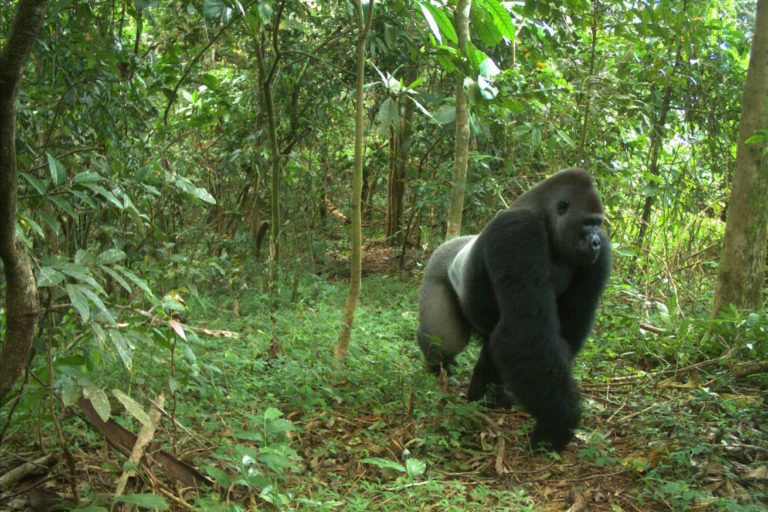Nigeria’s rainforests were once home to a diverse array of wildlife, from giraffes to chimpanzees. But the growing impacts of climate change increasingly threaten this landscape. Rising temperatures, erratic rainfall, and the shrinking of Lake Chad, now just a fraction of its former size, are forcing animals to flee or perish. Giraffes that once roamed freely in the north have vanished, their majestic presence now only a memory. Amphibians that thrived in the rich rainforests are slipping into extinction as the forests themselves shrink.
The Nigerian Giraffe (Giraffa camelopardalis peralta)
Though not globally extinct, the Nigerian giraffe population has suffered dramatically due to climate change and human-induced habitat loss. These giraffes once freely roamed northern Nigeria, but desertification has made their habitats uninhabitable. Habitat fragmentation, erratic rainfall, and prolonged droughts have reduced vegetation, leaving giraffes without food, and causing a sharp decline in their numbers.
Today, the remaining giraffe populations exist only in small, fragmented areas in Niger, with none left in Nigeria. This loss illustrates how climate change, coupled with habitat destruction, can push species towards extinction.
The West African Lion (Panthera leo)
The West African lion, once a common sight in Nigeria’s savannahs, is now critically endangered, with only a few individuals remaining. Lions in Nigeria have faced significant habitat loss due to agricultural expansion, poaching, and human-wildlife conflict. Climate change exacerbates these threats, degrading the savannah ecosystems where lions hunt.
The destruction of grasslands and more frequent droughts have drastically reduced the prey available, pushing the species to the brink of extinction in Nigeria.
Nigeria’s Amphibians: Disappearing Rainforest Species
Nigeria’s rainforest regions, such as the Cross River and Niger Delta, are home to many amphibians that are particularly vulnerable to environmental changes. Amphibians, which depend on stable moisture levels, are among the first to suffer from climate change. Rising temperatures and erratic rainfall have disrupted breeding cycles and reduced suitable habitats.
Species like the Nigeria Banana Frog (Afrixalus nigeriensis) and other endemic amphibians are experiencing sharp population declines due to deforestation, agricultural expansion, and changing climate conditions. The loss of wetlands and forests is leading to localized amphibian extinctions.
The Desert Warthog (Phacochoerus aethiopicus)
Once common in northern Nigeria, the desert warthog is another species severely impacted by climate change. The Sahara Desert’s expansion into northern Nigeria has reduced the species’ habitat, leading to its local extinction. Desertification, driven by rising temperatures and prolonged droughts, has transformed once-fertile savannahs into barren landscapes.
The disappearance of water sources and vegetation has wiped out the desert warthog in Nigeria, symbolizing the broader crisis of desertification in the region.
The Nigerian-Cameroon Chimpanzee (Pan troglodytes ellioti)
The critically endangered Nigerian-Cameroon chimpanzee is one of the world’s rarest chimpanzee subspecies. While not yet extinct, climate change poses a grave threat to their survival. Found in southeastern Nigeria’s forests, these primates rely on dense forests for food and shelter. However, deforestation and climate-driven habitat changes are fragmenting their environment.
Rising temperatures and shifting rainfall patterns are altering forest ecosystems, reducing food sources like fruit-bearing trees and threatening the chimpanzees’ future in Nigeria.
Ecological Impact
The extinction of these species threatens not only Nigeria’s biodiversity but also the ecosystems that millions of people depend on. The Nigerian giraffe, for instance, played a crucial role in maintaining the savannah by browsing on tall trees, which helped control vegetation and promote biodiversity. Their absence disrupts the ecological balance and weakens local economies that once relied on ecotourism.
Lions, as apex predators, helped regulate herbivore populations, preventing overgrazing and supporting plant growth. Their extinction threatens the delicate balance of Nigeria’s savannah ecosystems and the cultural heritage tied to these majestic animals.
Amphibians, such as frogs, are essential indicators of environmental health. Their sensitivity to water quality, temperature, and pollution makes them vital to monitoring ecosystem stability. Their decline signals weakening ecosystems, which can have consequences for human health and agriculture.
Similarly, desert warthogs played a role in maintaining savannah soil health, aerating the ground and preventing desertification. Their extinction reduces the resilience of the land and contributes to biodiversity loss, which affects local agriculture and wildlife tourism.
Chimpanzees, crucial for forest regeneration through seed dispersal, are vital for maintaining forest health. Forests, in turn, provide essential resources to humans, including timber, medicine, and carbon sequestration to combat climate change. The decline of chimpanzees reflects broader environmental degradation with significant implications for human livelihoods.
A Call to Action
The loss of species in Nigeria due to climate change is a stark warning of the broader environmental challenges the country faces. While factors like habitat destruction and poaching play a role, climate change is an accelerating force behind species extinction. From the drying wetlands of the north to the shrinking rainforests in the south, Nigeria’s ecosystems are undergoing profound changes.
Urgent action is required to mitigate the effects of climate change and protect Nigeria’s biodiversity. Conservation initiatives, reforestation efforts, and sustainable land-use practices can slow the rate of extinction and preserve Nigeria’s natural heritage for future generations. Without immediate efforts, many more species may be lost in the coming decades.
Nigeria's diverse ecosystems, particularly its rainforests and savannahs, are facing severe threats due to climate change and human activities. The Nigerian giraffe population has disappeared from the country, driven out by habitat loss and desertification. Similarly, the West African lion faces critical endangerment due to habitat destruction and reduced prey availability exacerbated by environmental changes. Amphibians endemic to Nigeria's rainforests are experiencing rapid population declines due to deforestation, erratic rainfall, and habitat loss.
The desert warthog has suffered from the Sahara's expansion, resulting in its local extinction in northern Nigeria. Also threatened is the critically endangered Nigerian-Cameroon chimpanzee, which faces habitat fragmentation and a reduction in food sources. The extinction or endangerment of these species disrupts ecological balance, impacts human economies reliant on biodiversity, and signals broader environmental degradation.
Efforts to mitigate climate change and protect Nigeria's biodiversity through conservation, reforestation, and sustainable practices are urgently needed. Without immediate intervention, the country's rich natural heritage faces further decline, posing significant risks to ecosystems that support both wildlife and human communities.






